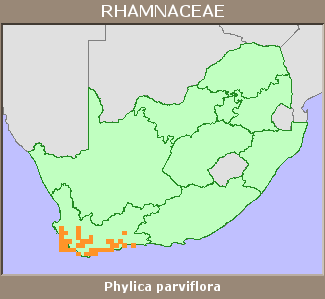|
Scientific Name | Phylica parviflora P.J.Bergius |
Higher Classification | Dicotyledons |
Family | RHAMNACEAE |
National Status |
Status and Criteria | Least Concern |
Assessment Date | 2005/06/30 |
Assessor(s) | W. Foden & L. Potter |
Justification | Although this species has lost some habitat to coastal and urban development, it is widespread, and the overall population has not declined significantly. |
Distribution |
Endemism | South African endemic |
Provincial distribution | Western Cape |
Range | Hopefield to Knysna. |
Habitat and Ecology |
Major system | Terrestrial |
Major habitats | Fynbos |
Description | Sandy coastal flats and low hills. |
Population |
Population trend | Stable |
Assessment History |
Taxon assessed |
Status and Criteria |
Citation/Red List version | | Phylica parviflora P.J.Bergius | Least Concern | Raimondo et al. (2009) | |
Bibliography |
Goldblatt, P. and Manning, J.C. 2000. Cape Plants: A conspectus of the Cape Flora of South Africa. Strelitzia 9. National Botanical Institute, Cape Town.
Raimondo, D., von Staden, L., Foden, W., Victor, J.E., Helme, N.A., Turner, R.C., Kamundi, D.A. and Manyama, P.A. 2009. Red List of South African Plants. Strelitzia 25. South African National Biodiversity Institute, Pretoria.
|
Citation |
| Foden, W. & Potter, L. 2005. Phylica parviflora P.J.Bergius. National Assessment: Red List of South African Plants version 2024.1. Accessed on 2025/12/23 |
 Comment on this assessment
Comment on this assessment


